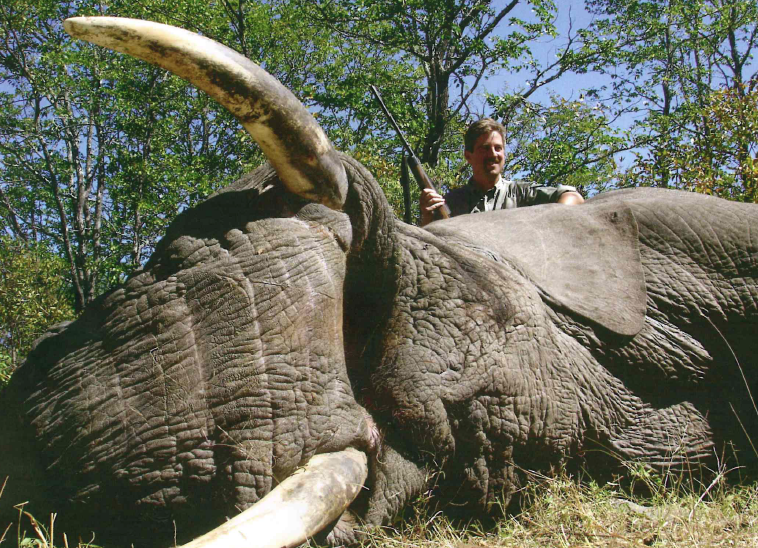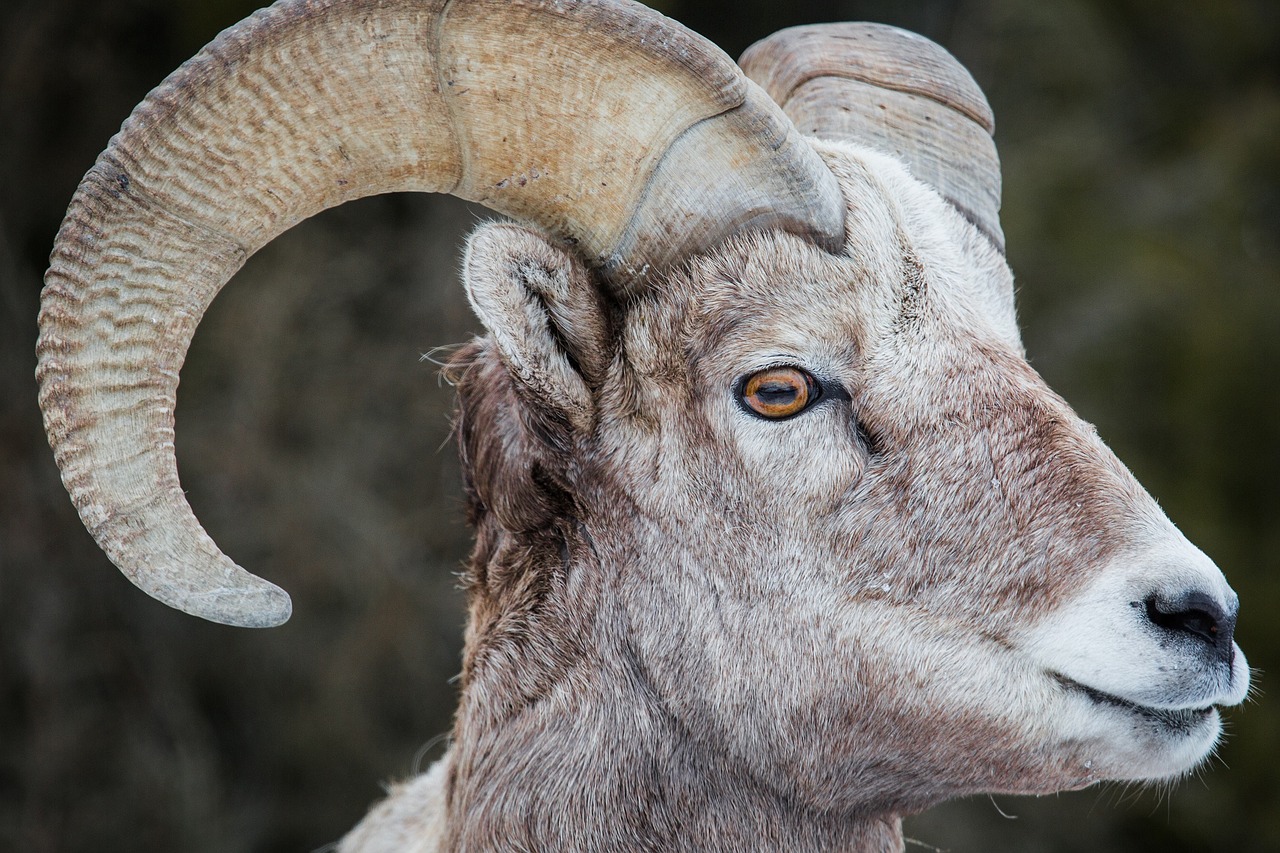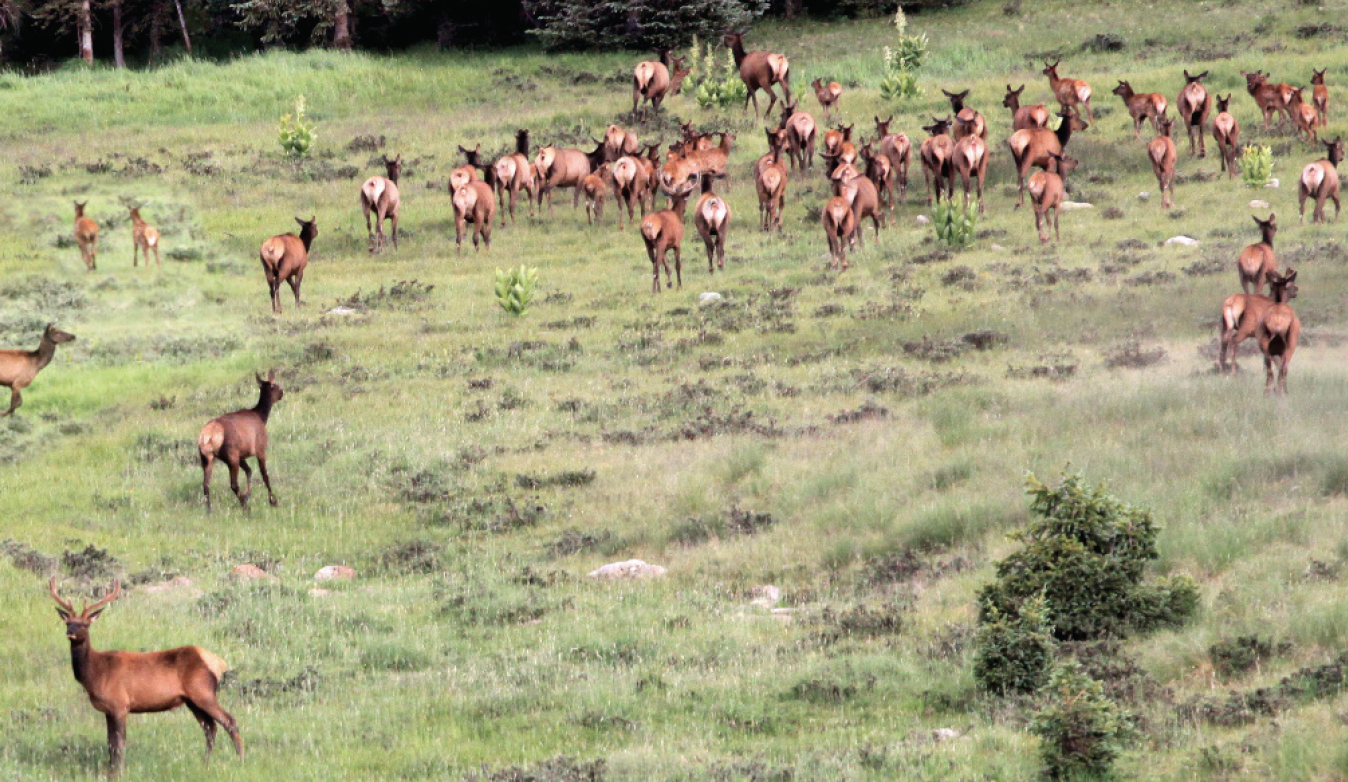A team of diligent agencies and individuals worked together for years to secure the long-awaited guilty plea from Oregon’s serial poacher.
Kathy Spengler needed to paint a picture. Not a paint-by-numbers type portrait, but one that had to be closer to a masterpiece – the portrait of a poacher.
A special agent with the U.S. Fish and Wildlife Service’s Office of Law Enforcement based in Wilsonville, Oregon, in 2018 Spengler inherited an ongoing wildlife poaching investigation. There were numerous parts and pieces of evidence that reached back many years, and the potential crime scene covered thousands of acres of rough, remote terrain.
Catching a poacher under these circumstances would require ongoing collaboration with partners in the Oregon State Police Fish and Wildlife Division (OSP) and Crater Lake National Park to sort through the information. Then Spengler would need to use the evidence like dabs of paint on a palette to create a picture that could be handed off to the U.S. Department of Justice for prosecution.
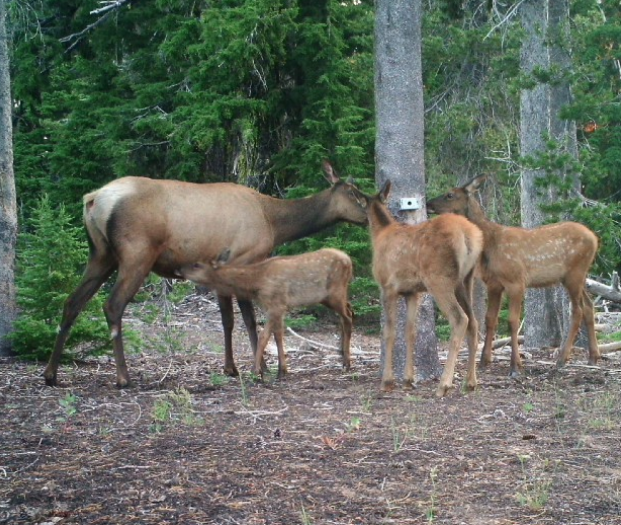
A few small herds of Roosevelt elk call Crater Lake National Park their summer home. Photo by Crater Lake National Park.
Finally, after years of persistence, the team used the evidence to paint a portrait of a poacher killing deer and elk inside the boundaries of Crater Lake National Park.
On February 4, 2021, poacher Adrian Duane Wood of Oregon was sentenced for violating the Lacey Act by illegally poaching a trophy bull elk in Crater Lake National Park. Wood was sentenced to three years’ federal probation, banned for the term of his probation from Crater Lake National Park, restricted from hunting for the duration of his probation and required to pay $42,500 in restitution to the National Park Service for the wildlife illegally taken from the park. Wood also must be in a residential reentry program for 180 days and complete 300 hours of community service.

The meadows and thick forests of Crater Lake National Park are home to many species of wildlife, including elk and deer. Photo by Crater Lake National Park.
A Fresh Canvas
It all started with rumors and tips.
In 2014, multiple sources told National Park Service rangers and OSP troopers that Wood had killed several deer and elk on the west side of Crater Lake National Park after baiting them into a meadow with rock salt. Those reports led to the start of the multi-agency investigation.
Throughout 2015, the National Park Service and OSP continued receiving reports of Wood’s illegal poaching. Park rangers found carcasses and evidence of salt use in an area of the park thought to be frequented by Wood.
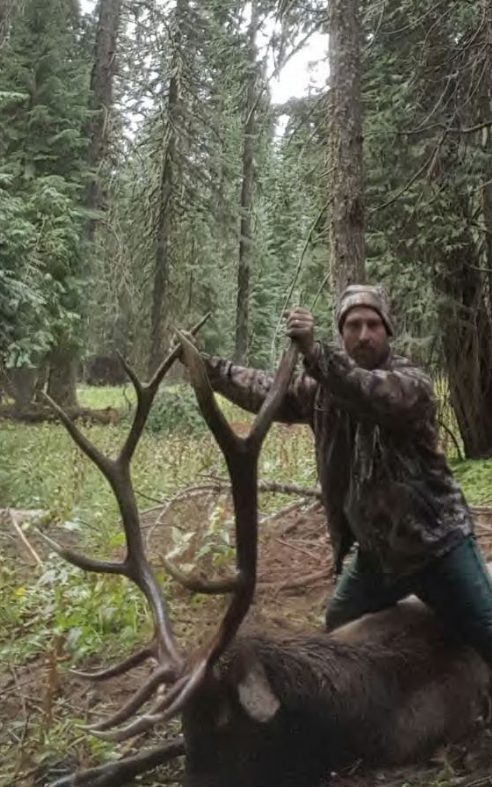
Poacher Adrian Wood pleaded guilty to a Lacey Act charge after he poached this bull elk from Crater Lake National Park on Sept. 22, 2016. Photo provided by Department of Justice.
On September 22, 2016, OSP trooper Mike Cushman encountered Wood in his vehicle near the boundary of Crater Lake National Park. Although Wood stated he had not been hunting, the trooper observed blood on Wood’s hands and clothing. When questioned further, Wood produced a partially validated Oregon Department of Fish and Wildlife archery elk tag that contained traces of blood.
The next day, Cushman returned to the area and walked into Crater Lake National Park. He watched for ravens and followed signs of human activity. Soon, he discovered a freshly killed and partially butchered elk. Its antlers had been removed.
“By the time trooper Cushman came back to town, pictures of Wood posing with this big bull elk had already been sent around town,” Spengler said. “Trooper Cushman looked at the pictures and said, ‘Wow. That is where I was at.’ He went back to the park and matched up the location of the carcass with the photo of Wood with the bull elk.”
Special agent Jimmy Barna, the lead investigator on the case for the U.S. Fish and Wildlife Service at the time, obtained a search warrant for Wood’s residence. Critical pieces of evidence were located during the search on Oct. 4, 2016, including several wildlife specimens and racks, freezers of meat, digital evidence and Wood’s GPS unit.
That evidence served as the underpainting, the first layer of paint that is the foundation on a fresh canvas. Next, it was time to start adding layers and details to see if the evidence would paint a recognizable portrait.
Adding Layers of Detail
Spengler took over the case in 2018. As she reviewed the files, the GPS unit caught her attention. Spengler hoped to paint a clear image of Wood’s movements through data found on the GPS device.
Liz Cruz, a geographer from the Service’s Columbia Pacific Northwest Regional Office in Portland, took the GPS data points and placed them on a map, overlaying it with roads and Crater Lake National Park boundaries.
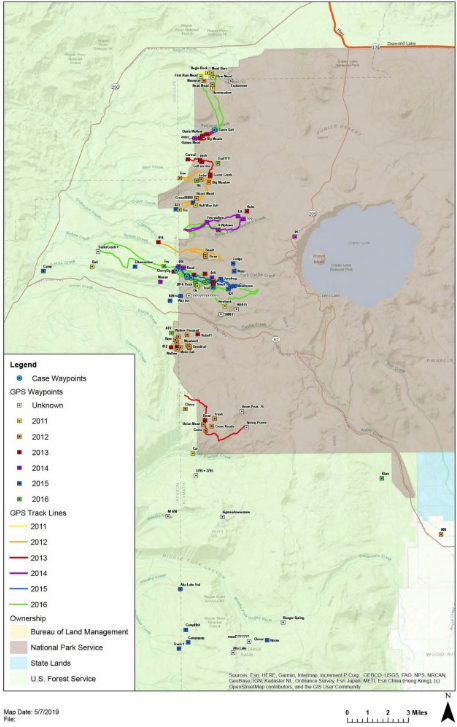
U.S. Fish and Wildlife Service geographer Liz Cruz used data from a seized GPS unit to map multiple trips that a poacher made into Crater Lake National Park from 2011 through 2016. Map by Liz Cruz / USFWS
“Liz’s map was beautiful,” Spengler said. “She was able to plot the waypoints and track logs, which helped show us where to look for evidence and start tying everything together. The maps confirmed that the majority of his GPS hunting waypoints and track logs between 2011 and 2016 were within the boundaries of Crater Lake National Park.” Some waypoints on the GPS unit were pinned with key words such as “4 Wallows,” “Way Inn,” and “Saalt,” along with locations of parked vehicles on Forest Service roads that ended outside the park.
Spengler started piecing together a timeline by matching track logs and dates with photos, social media posts, Oregon Turn-In-Poachers (TIP) Line reports from the public and other evidence.
“We were able to tie it all together with all the digital evidence, the statements he made, and the photos. For sure, the September 22, 2016 elk — that big bull he poached from the park — it was crystal clear what happened by the evidence,” Spengler said.
But the evidence revealed even more. Just five days before he killed the bull elk, there were reports that Wood had killed a deer and elk in the park.
“On September 17, 2016, someone had reported through the TIP Line that Wood had taken an elk and a deer. I’m looking at the map and his track log on September 17, and I see this big red splotch on the map,” Spengler said. “I called Liz and said, ‘What was he doing and how long was he there?’ She could zoom in on the points from the track log and see he was going back and forth at the edge of a meadow for 45 minutes. I went back into Crater Lake National Park with the park ecologist, and we found cow elk remains there at that very spot on the map.”
The painting became more refined with each data point and piece of evidence. Then it was time to add more details to the portrait through forensic analysis of the evidence.
More Brushstrokes
Next up at the easel was Brian Hamlin, a forensics scientist in the genetics section at the Service’s Forensics Laboratory in Ashland, Oregon. Hamlin has worked for 22 years at the world’s only full-service forensics laboratory dedicated to wildlife.
“The evidence has a story to tell, and we’re here to help it tell that story,” Hamlin said.
Hamlin extracted DNA from remains from the field, the meat in the freezer, and the wildlife specimens and antlers seized from Wood’s residence. In total, Hamlin and his colleagues in the pathology, morphology and criminalistic sections of the laboratory analyzed 128 pieces of evidence.
“Genetics certainly played a big role in developing the forensics triangle — linking the victim, the crime scene and the suspect,” Hamlin said. “The DNA from the bull elk carcass they recovered from Crater Lake, along with the archery hunting tag containing trace blood that OSP had seized from the suspect, both matched the DNA from the set of antlers seized from the residence. In multiple instances, we were able to link the suspect directly to evidence found in the park and suspect’s residence through DNA.”
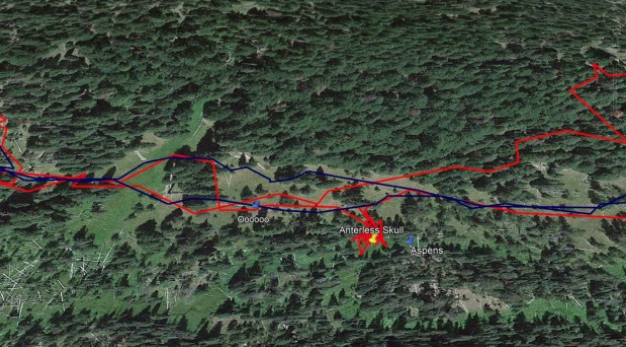
The red line indicates the steps of a poacher on Sept. 17, 2016. Special agent Kathy Spengler was able to follow the path to find evidence of a poached elk in Crater Lake National Park. The blue line indicates his path on Sept. 4, 2016.
The laboratory’s tests revealed that Wood possessed parts of at least 13 elk, 12 deer, and one black bear. Analysis in the pathology and criminalistic sections of the lab revealed the elk taken on Sept. 22, 2016, had been killed by a gunshot instead of by archery.
All of the forensics evidence, layered together with text messages, social media posts, reports of Wood’s activities from members of the public and other hunters, his GPS track logs and waypoints, and photos painted a dramatic and dark image.
It was the portrait of a serial poacher at Crater Lake National Park.
The Finished Portrait of a Poacher
Spengler presented the finished portrait to the U.S. Attorney’s Office for the District of Oregon. Adam E. Delph, Assistant U.S. Attorney for the District of Oregon, served as the government’s lead attorney for the case.
Wood was indicted May 1, 2019, by a federal grand jury in Medford, Oregon. On August 17, 2020, Wood pleaded guilty to the Lacey Act charge and agreed to pay restitution to the National Park Service for the wildlife illegally taken from the national park. In total, investigators definitively linked six seized specimens to elk or deer poached by Wood in the national park in 2015 and 2016.
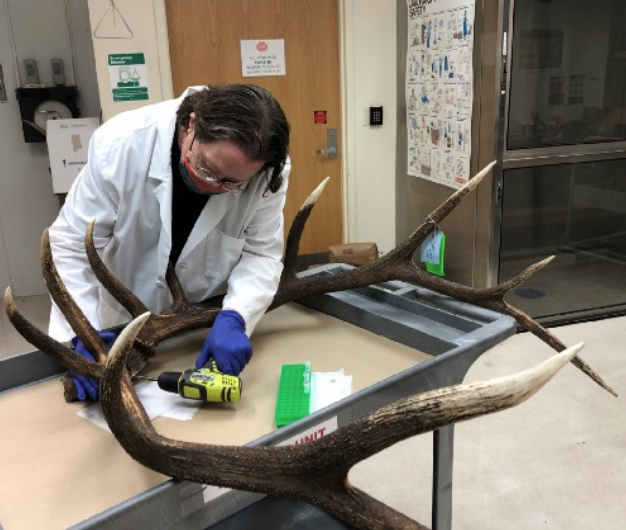
Brian Hamlin, a forensics scientist at the Service’s Forensics Laboratory in Ashland, Oregon, uses a drill to extract DNA samples from a set of antlers from a bull elk that was killed in Crater Lake National Park. Photo by Kathy Spengler / USFWS
“One of the most important duties of the U.S. Attorney Office is to enforce our nation’s environmental laws,” said Acting U.S. Attorney Scott Erik Asphaug. “These laws protect vulnerable wildlife populations, ensuring their continued health and survival. Mr. Wood preyed on elk and deer unaccustomed to being hunted and thus lacking the instinct to protect themselves. Mr. Wood showed no remorse for his crimes, bragged about his poaching on social media, and even engaged his minor son in his illegal activity. Without the determination and persistence of federal and state investigators, Mr. Wood’s destructive behavior would continue to this day.”
The importance of catching and convicting this poacher was particularly important to the Oregon Hunters Association. The group provided a supporting letter at sentencing, asking the judge to impose a strong sentence in the case.
“Poachers are thieves, stealing wildlife from all of us,” said Paul Donheffner, legislative committee chairman for the Oregon Hunters Association. “They are armed robbers, often preying on wildlife at night and in closed areas, such as Crater Lake National Park. Legal hunting is regulated to protect wildlife populations in a sustainable way. Poachers upset the sustainable balance and are a key factor in why some deer and elk herds are below management objectives.
“Adrian Wood’s case is a prime example of egregious poaching…The Department of Justice, U.S. Fish and Wildlife Service and Oregon State Patrol spent so much time, money and effort on this case that the very least we could do was write a letter asking the court to drop the hammer as hard as possible. If nothing else, perhaps this sends a message to others.”
Signing the Masterpiece
This case hinged on the dedication of the multiple agencies and individuals who worked together over a long period of time. Many of the investigators and prosecutors moved on to new jobs or retired during the multi-year case, handing it off to new people to finish the portrait.
Because of this diligence and commitment, the Department of Justice was able to secure a guilty plea.
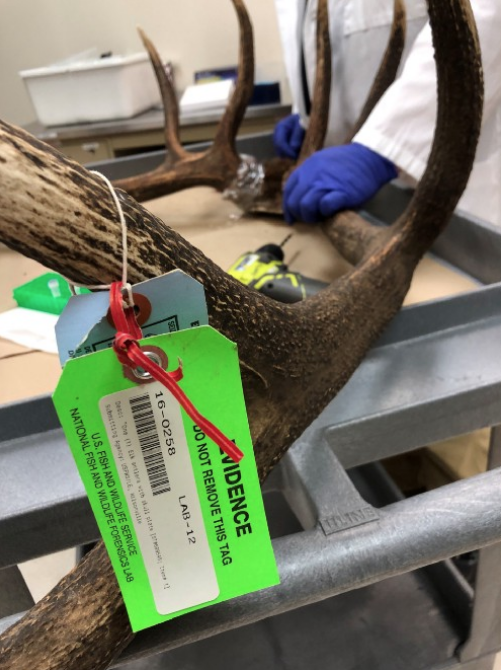
The evidence tag on a set of elk antlers at the U.S. Fish and Wildlife Service’s Forensics Lab in Ashland, Oregon. Photo by Kathy Spengler / USFWS
“We had a great team and everyone worked together. Crater Lake National Park and Oregon State Patrol were heavily involved from the beginning of the case. National Park Service ranger Shane Rogers collected the bull elk carcass from the field, and was also responsible for finding other evidence that proved to be essential to the investigation. He reached out to the U.S. Fish and Wildlife Service saying they had a Lacey Act case and was going to need the Forensics Laboratory’s help with identifying some of the genetic components of the case,” Spengler said. “The Department of Justice really embraced this case as well. It took a real team to complete this case.”
There were many people who had a hand in solving this poaching case, including:
- S. Fish and Wildlife Service — Office of Law Enforcement special agents Jimmy Barna, Sheila O’Connor and Kathy Spengler; Forensics Laboratory staff Laura Daugherty, Brian Hamlin, Rachel Jacobs, Katie Poplin and Tabitha Viner; and National Wildlife Refuge System geographer Liz Cruz.
- Oregon State Police — Senior Fish and Game trooper Mike Cushman, Sgt. Jim Collom, and others.
- Crater Lake National Park — Park rangers Walters, Shane Rogers, Jordan Neumann and Kean Mihata; ecologist Sean Mohren; and others.
- S. Department of Justice — Adam E. Delph, Assistant U.S. Attorney for the District of Oregon.
With the case closed, the team can finally put away their paint and clean their brushes. This masterpiece portrait, painted by more than a dozen of dedicated professionals, is complete.
Article “Portrait of a Poacher” by Brent Lawrence, a public affairs officer with the U.S. Fish and Wildlife Service’s Columbia Pacific Northwest Region
 This is a full-color edition of the very first Boy Scouts Handbook, complete with the wonderful vintage advertisements that accompanied the original 1911 edition, Over 40 million copies in print!
This is a full-color edition of the very first Boy Scouts Handbook, complete with the wonderful vintage advertisements that accompanied the original 1911 edition, Over 40 million copies in print!
The original Boy Scouts Handbook standardized American scouting and emphasized the virtues and qualifications for scouting, delineating what the American Boy Scouts declared was needed to be a “well-developed, well-informed boy.” The book includes information on: The organization of scouting, Signs and signaling, Camping, Scouting games, Description of scouting honors.
Scouts past and present will be fascinated to see how scouting has changed, as well as what has stayed the same over the years. Shop Now


